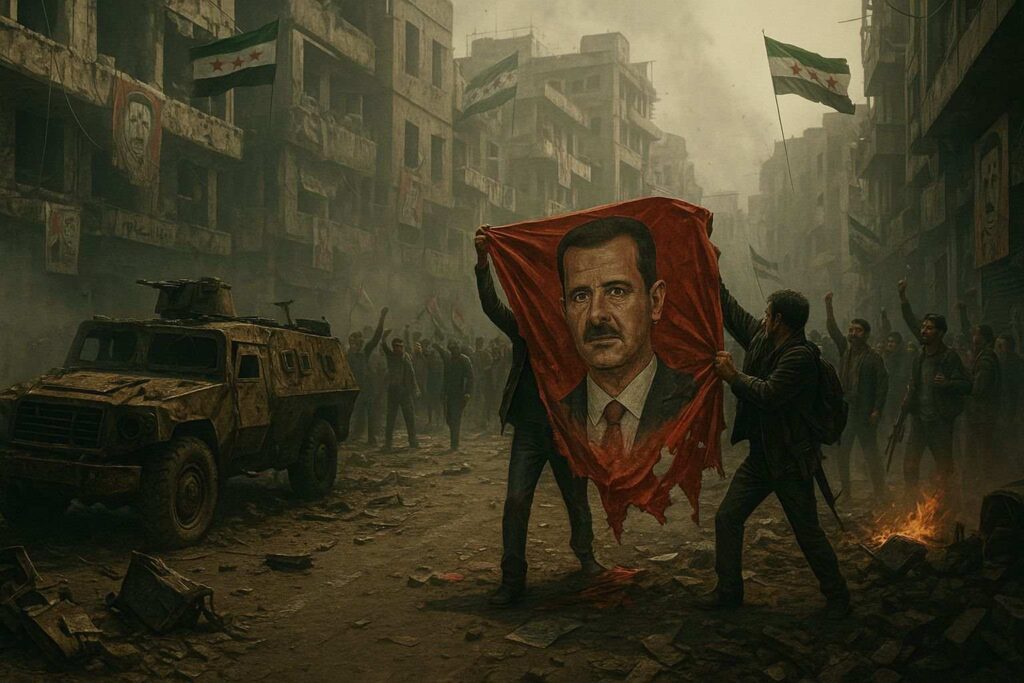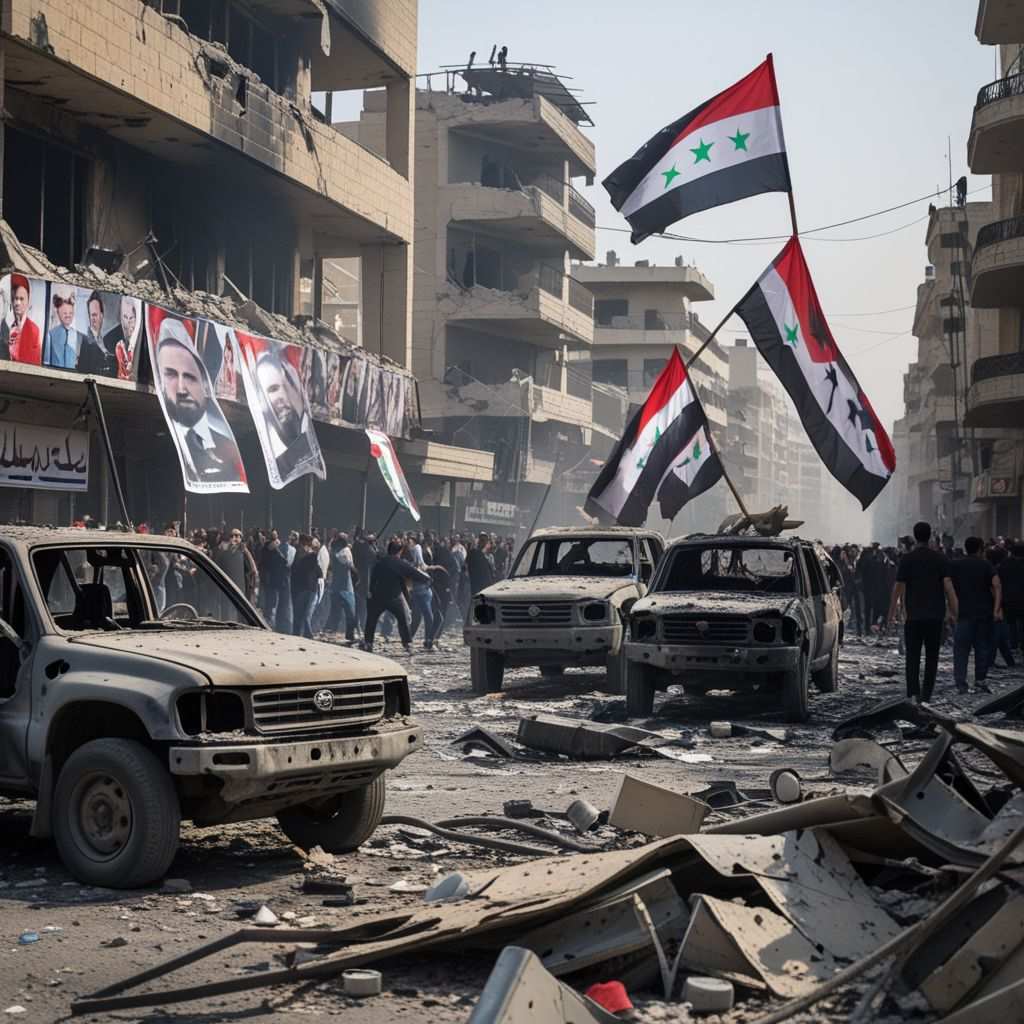Syria’s Tumultuous Journey: From Dictatorship to an Uncertain Dawn

For over five decades, Syria was synonymous with the iron-fisted rule of the Assad family. A nation steeped in ancient history and diverse cultures, it became a crucible of conflict, drawing in global powers and leaving an indelible mark on the lives of millions. This article delves into Syria’s complex journey, from its post-colonial struggles and the rise of the Assad dynasty to the devastating civil war, the emergence of extremist groups, and the dramatic events of late 2024 that finally saw the collapse of Bashar al-Assad’s regime. We will explore the intricate web of internal and external forces that shaped its destiny, the human cost of prolonged conflict, and the precarious path it now treads towards an uncertain future.
A Nation Forged in Conflict: Early History and the Rise of the Assads
Syria, a land bridging continents and cultures, was once a part of the vast Ottoman Empire until its dissolution after World War I. Following the war, European powers, primarily France, took control, ruling the region from 1918 to 1946. Independence in 1946, however, did not usher in an era of peace. Instead, Syria found itself grappling with internal divisions rooted in its diverse religious and ethnic landscape. The population, predominantly Sunni Muslim, also comprised significant Shia Muslim (including Alawites) and Christian minorities, alongside Arab and Kurdish ethnic groups. These inherent differences, coupled with political instability, set the stage for future conflicts.
The mid-20th century saw a series of military coups and political shifts. The Arab Socialist Baath Party, a secular and socialist movement, gained prominence, attracting students, minorities, and young army officers. In 1970, General Hafez al-Assad, an ambitious Minister of Defense and an Alawite, seized power, becoming president in 1971. He swiftly established a dictatorship, consolidating power through repression, as evidenced by the brutal 1982 Hama Massacre, where an estimated 20,000 people were killed in response to a Sunni militant uprising. Despite his authoritarian rule, Hafez al-Assad oversaw periods of economic development, land reform, and educational advancement, which garnered him a degree of popular support.

Upon Hafez al-Assads death in 2000, his son, Bashar al-Assad, an ophthalmologist by training, unexpectedly ascended to the presidency. The constitution was even amended to lower the minimum age for the presidency to accommodate him. Bashar initially promised reforms, but his shift towards a market-oriented economy led to the dismantling of social welfare programs, rising unemployment, and growing public discontent. This economic hardship was compounded by a severe four-year drought from 2006 to 2010, which devastated agricultural lands, increased food prices, and further fueled public frustration. The stage was set for a dramatic upheaval.
The Arab Spring and the Descent into Civil War
The spark that ignited the Syrian inferno was the Arab Spring, a wave of pro-democracy uprisings that swept across the Middle East and North Africa in late 2010. Inspired by the self-immolation of Mohamed Bouazizi in Tunisia, which triggered widespread protests and the overthrow of dictators in Egypt and Libya, Syrians too began to demand change. Initially, Bashar al-Assad dismissed the possibility of such protests in Syria, believing his regime was immune. However, in March 2011, in the southern city of Deraa, the arrest and torture of schoolboys for anti-government graffiti ignited a firestorm. The brutal response by security forces, including killings and the suppression of funerals (which had become rallying points), only served to escalate the protests.
As the governments crackdown intensified, a critical turning point arrived in July 2011 when soldiers, refusing to fire on their own people, began to defect, forming the Free Syrian Army (FSA). This marked the formal beginning of the Syrian Civil War. The FSA, alongside other rebel groups, quickly gained control of significant territories, including major cities like Aleppo and Raqqa. What began as a non-sectarian uprising against a tyrannical regime gradually morphed into a complex sectarian conflict. Assad, an Alawite from a minority sect, had long favored his community, while the majority Sunni population felt marginalized. This underlying tension was exploited and exacerbated by foreign intervention.
The conflict rapidly became a proxy war, drawing in regional and international powers with their own geopolitical interests. Countries like Turkey, Qatar, and Saudi Arabia, predominantly Sunni, threw their support behind the rebels. Conversely, Iran and Hezbollah, with their Shia majorities, staunchly backed the Assad regime. The involvement of global superpowers further complicated the landscape: the United States, Britain, France, and Germany supported various rebel factions, while Russia, a long-standing ally, provided crucial military and diplomatic support to Assad, frequently vetoing UN resolutions aimed at condemning his actions.

The Scourge of Extremism: ISIS, Chemical Weapons, and Human Atrocities
As the civil war raged, a new and terrifying element emerged: extremist militant groups. Around 2012, Al-Qaeda, through its Syrian affiliate Jabhat al-Nusra, began to exploit the chaos. In a cynical move, Bashar al-Assad himself released hundreds of extremist militants from prisons in mid-2011. His intention was to create a more monstrous enemy, thereby presenting himself to the world as a secular leader fighting jihadist forces, and to discredit the moderate rebels by associating them with these extremists. This strategy backfired catastrophically.
The most brutal of these groups was the Islamic State of Iraq and Syria (ISIS), formed in April 2013 by Abu Bakr al-Baghdadi, merging the Islamic State of Iraq with Jabhat al-Nusra. ISIS rapidly expanded, controlling vast swathes of territory in both Syria and Iraq by 2015, establishing its self-proclaimed caliphate with Raqqa as its capital. Under ISIS rule, horrific atrocities were committed, including genocide against minorities and the destruction of invaluable cultural heritage sites. The sheer brutality of ISIS united nearly every nation in the world against it, including former adversaries like the US and Russia, who both launched military campaigns to counter its expansion.
Amidst this escalating conflict, the Assad regime repeatedly used chemical weapons against its own population, a grave violation of international law. The most infamous incident occurred on August 21, 2013, when a sarin gas attack killed over 1,000 people. Despite international condemnation and a ‘red line’ warning from the United States, these attacks continued, highlighting the regime’s disregard for human life. Beyond chemical warfare, the Assad regime maintained a network of torture camps, with Sednaya Prison gaining notoriety as a ‘human slaughterhouse.‘ Amnesty International reported that over 30,000 people were killed in this prison between 2011 and 2018, subjected to unimaginable torture and inhumane conditions.
A Labyrinth of Alliances: Complex War Dynamics and Assads Dramatic Fall
The Syrian conflict evolved into a bewildering tapestry of shifting alliances and conflicting objectives. While the US and Russia found common ground in fighting ISIS, their broader aims in Syria remained diametrically opposed: the US supported the rebels, while Russia propped up Assad. This created a complex battleground where various factions, including the Syrian opposition, ISIS, the Kurds, and even Turkey, engaged in multi-sided conflicts. Turkey, for instance, fought against Kurdish forces, who were often backed by the US, adding another layer of complexity to the already convoluted situation.
The widespread destruction and relentless violence led to one of the largest humanitarian crises of the 21st century. By 2015-2016, millions of Syrians were displaced internally, and millions more became refugees, seeking asylum in neighboring countries and beyond. Entire cities were reduced to rubble, a stark testament to the ferocity of the conflict.

By 2019, ISIS had been largely defeated, thanks to concerted efforts by the US-led coalition and Kurdish forces in the north, and Assads forces, backed by Russia, in other areas. This, however, led to a stalemate, with Syria effectively partitioned: Assad controlled roughly two-thirds of the country, Kurdish forces held the northeast, and various rebel groups, primarily Hayat Tahrir al-Sham (HTS), maintained control over the northwest (Idlib).
The fragile equilibrium shattered in late 2024. Bashar al-Assad, perhaps miscalculating the resolve of his opponents and the diminished capacity of his allies (Russia and Iran were increasingly preoccupied with the wars in Ukraine and Israel-Palestine, respectively), launched a new offensive against rebel-held areas. This proved to be his gravest misstep. On November 27, 2024, HTS and allied opposition groups launched a swift counter-offensive, dubbed Operation Deterring Aggression.
The swift momentum of their offensive overwhelmed the governments defenses before it could react. Within two days, Aleppo, Syrias largest city and economic hub, fell to the rebels. With his forces demoralized and his key international backers stretched thin, Assads regime crumbled with astonishing speed. On December 8, 2024, rebel forces entered Damascus, encountering little resistance. The Syrian army, including elite units, reportedly laid down their arms, their loyalty eroded by years of conflict and unpaid salaries. Bashar al-Assad fled the country, reportedly to Moscow, marking the end of 54 years of Assad family rule and a 14-year civil war that had claimed over 500,000 lives and displaced 13 million people.
An Uncertain Dawn: Syria Post-Assad and the Dictators Dilemma
The fall of Bashar al-Assad on December 8, 2024, ignited celebrations across Syria, with people dismantling symbols of the regime and reclaiming public spaces. However, the future of Syria remains fraught with challenges. An interim government was formed on March 29, 2025, led by Ahmed al-Sharaa, the leader of Hayat Tahrir al-Sham (HTS). This group, once an Al-Qaeda affiliate, has attempted to rebrand itself, with al-Sharaa claiming to have severed ties with extremist ideologies and seeking to establish himself as a nationalist leader. In a significant development, the United States announced on July 7, 2025, its decision to revoke HTSs terrorist designation, signaling a potential shift in international perception and engagement.

Despite these developments, the landscape of post-Assad Syria is complex and fragmented. HTS now controls much of western Syria, including the capital Damascus. The Kurdish-led Syrian Democratic Forces (SDF) maintain control over the northeast, while the Turkish-backed Syrian National Army (SNA) holds sway in other parts of the northwest. The presence of various armed groups and ongoing localized clashes underscore the fragility of the new order. Concerns persist about the treatment of minorities under the new administration and the potential for renewed conflict.
The dramatic collapse of the Assad regime serves as a powerful illustration of the concept known as the Dictators Dilemma. This phenomenon describes how authoritarian leaders, surrounded by sycophants and isolated from the true sentiments of their populace, often make decisions based on flawed information, ultimately leading to their downfall. The Assad familys 54-year reign, seemingly unshakeable, crumbled in a mere two weeks, a testament to the inherent instability of regimes built on repression and fear.
Also Read: The Mystery of D.B. Cooper – Top Conspiracy Theories That Still Haunt the FBI
Syria stands at a crossroads. The fall of the Assad regime, while celebrated by many, ushers in a period of immense uncertainty and challenges. The long and brutal civil war has left the country devastated, its infrastructure in ruins, and its people scarred. The interim government faces the monumental task of rebuilding a nation, fostering reconciliation among diverse factions, and addressing the deep-seated humanitarian crisis. The international community watches closely, hoping that this new chapter will bring stability and a better future for the Syrian people, but acknowledging that the path ahead is fraught with complexities and potential pitfalls. Only time will tell if Syria can truly emerge from the ashes of conflict and forge a lasting peace.
Sources
- Al Jazeera: Syria in 2024 – A Year That Changed Everything
- Al Jazeera: What Assad’s Collapse Says About the Arab World
- Brookings: The Assad Regime Falls — What’s Next?
- Georgetown: Assad’s Fall – Winners & Losers
- Global R2P: Syria Country Page
- Reuters: The ‘New Syria’ After Assad
- The Guardian: Syria’s War Ends Overnight


